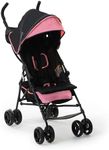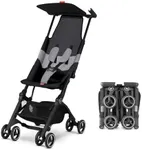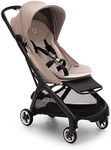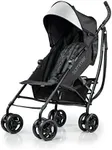Buying Guide for the Best Lightweight Stroller
Choosing a lightweight stroller can make outings with your child much easier, especially if you travel often, use public transportation, or need to carry the stroller up and down stairs. The key is to find a stroller that balances portability, comfort, and convenience for both you and your child. Understanding the main features and how they relate to your lifestyle will help you make the best choice.WeightThe weight of a stroller refers to how heavy it is to lift and carry. This is important because a lighter stroller is easier to transport, especially if you need to carry it up stairs, lift it into a car trunk, or take it on public transport. Lightweight strollers usually range from about 10 to 20 pounds. If you plan to carry the stroller often, look for models closer to 10 pounds. If you only need to lift it occasionally, a slightly heavier stroller may offer more features or stability.
FoldabilityFoldability describes how easily and compactly the stroller can be folded for storage or transport. This is crucial if you have limited space at home or in your car, or if you travel frequently. Some strollers fold with one hand, while others require two. Compact folds are best for small spaces or airplane travel, while larger folds may be fine if you have more storage room. Consider how and where you’ll store or carry the stroller to decide which folding style suits you.
Seat Comfort and ReclineSeat comfort and recline refer to how padded the seat is and whether it can be adjusted to different angles. This matters for your child’s comfort, especially on longer outings or if your child naps in the stroller. Some lightweight strollers have minimal padding and limited recline, making them best for short trips or older children. Others offer more support and multiple recline positions, which are better for younger babies or longer use. Think about your child’s age and how you plan to use the stroller to choose the right level of comfort.
Canopy SizeThe canopy is the cover that shields your child from sun, wind, or light rain. Canopy size is important for protecting your child’s sensitive skin and keeping them comfortable. Small canopies offer basic shade, while larger or extendable canopies provide more coverage. If you spend a lot of time outdoors or in sunny areas, a bigger canopy is a good choice. For mostly indoor use, a smaller canopy may be enough.
Storage BasketThe storage basket is the space under the seat where you can keep bags, snacks, or other essentials. The size and accessibility of the basket can make outings more convenient. Smaller baskets are common in lightweight strollers, but some offer enough space for a diaper bag or groceries. If you often carry a lot with you, look for a stroller with a larger, easy-to-access basket. If you travel light, a smaller basket may be sufficient.
Wheel Type and SuspensionWheel type and suspension affect how smoothly the stroller moves and how easy it is to push. Small, hard wheels are lighter and work well on smooth surfaces like sidewalks or malls. Larger wheels or those with suspension systems handle bumps and uneven ground better, making them ideal for parks or rougher terrain. Consider where you’ll use the stroller most often to decide which wheel type and suspension you need.
Harness SystemThe harness system is the set of straps that keep your child safely secured in the stroller. Most strollers have either a three-point or five-point harness. A five-point harness offers more security, especially for younger or more active children. If your child is older and sits still, a three-point harness may be enough. Always make sure the harness is easy to adjust and comfortable for your child.
















